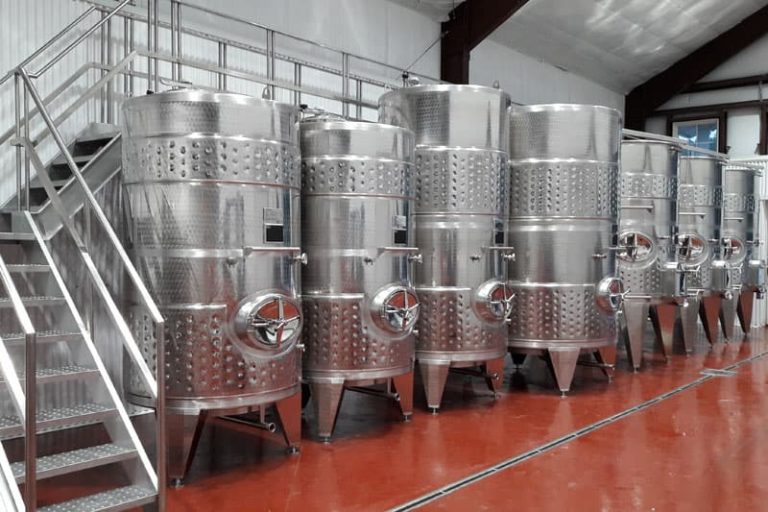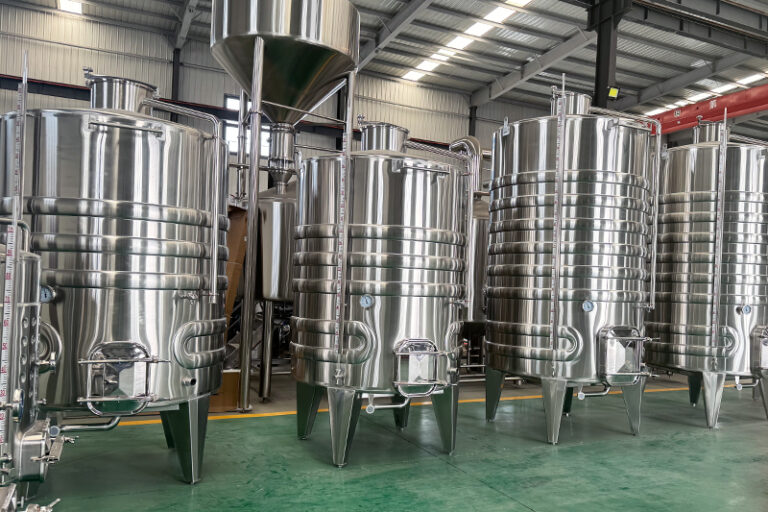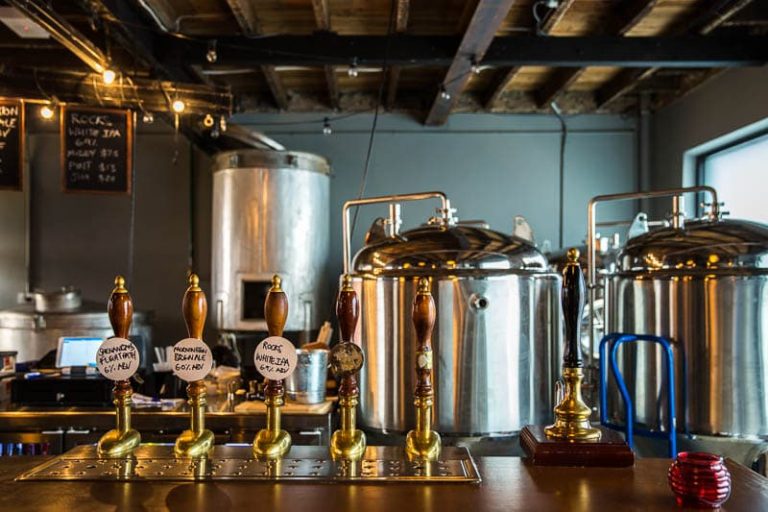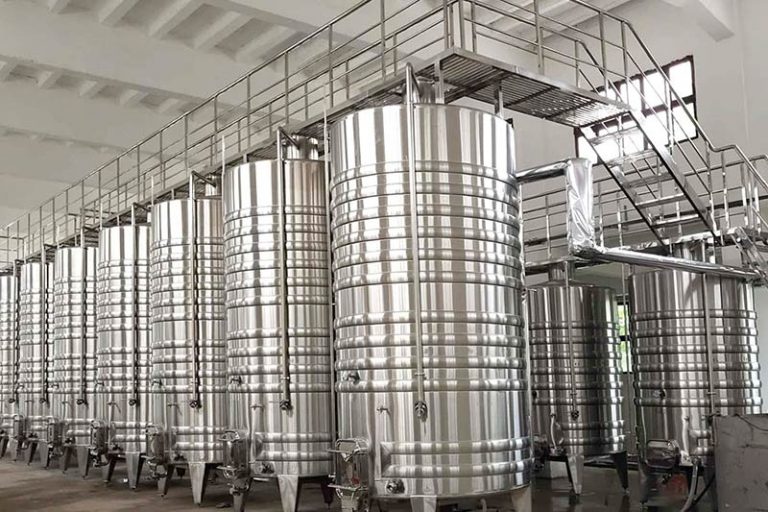Wine tanks play a vital role in the winemaking and storage process. Whether used for fermentation, storage, or aging, the quality and cleanliness of the wine tanks will directly affect the flavor, stability, and quality of the final wine. Proper cleaning and maintenance can not only extend the service life of the tank but also prevent contamination, ensuring the stable quality of each batch of wine.
Types of wine tanks
Stainless steel tanks
- Corrosion-resistant, will not react chemically with the wine
- Easy to clean and disinfect, low maintenance cost
- Controllable temperature, suitable for modern brewing technology
- It will not affect the flavor of the wine
Oak barrels
- Allow a small amount of oxygen to enter, which helps the wine mature and develop
- Give wine unique flavors, such as vanilla, smoke, and spicy flavors
- Help balance the structure of the wine
Concrete tanks
- Good micro-oxygenation, but it will not affect the flavor of the wine like oak barrels
- The temperature remains stable, suitable for long-term aging
- Gives the wine a smoother taste
Ceramic pot
- Traditional craft, a more natural combination with wine flavor
- Allow slight oxidation, giving the wine a soft taste
- Suitable for organic and natural winemaking methods
Glass Bottles
- Relatively low price, light weight, easy to carry
- Strong corrosion resistance
- Suitable for short-term storage and experimental small batch brewing

Types and selection of wine tanks
There are many types of wine tanks, mainly including stainless steel tanks, oak barrels, concrete tanks, and ceramic tanks. wine tanks of different materials have different characteristics, so when choosing, it is necessary to make comprehensive considerations based on the type of wine, brewing process, and storage requirements. Stainless steel tanks have become the main choice of modern wineries because they are corrosion-resistant, easy to clean, and do not affect the flavor of the wine. Oak barrels are widely used for aging high-end wines because they can give wine more layers of flavor. Concrete tanks are suitable for brewing methods that want to keep the wine stable while providing slight oxidation. Ceramic tanks are mainly used in some traditional or natural brewing wineries, which can provide unique mineral flavors and a soft taste.

How to Properly Clean and Maintain Wine Tanks?
Daily cleaning method of wine tanks
Daily cleaning of wine tanks is the key to maintaining stable wine quality. After each use, the tank needs to be thoroughly cleaned to remove wine residue, yeast residue, and possible microorganisms. Daily cleaning usually includes the following steps:
- The wine in the tank needs to be drained to ensure that there is no residue in the tank. Then use warm water for a preliminary rinse to remove wine stains and sediments on the surface.
- Food-grade alkaline cleaners (such as sodium carbonate solution) can be used to spray and soak the inside of the tank, usually for 15 to 30 minutes, to decompose stubborn dirt and organic matter.
- The tank wall needs to be physically scrubbed with a soft brush or high-pressure water gun to ensure that all residues are thoroughly removed.
- Use food-grade disinfectants (such as chlorine dioxide or peracetic acid) for disinfection and rinse thoroughly with clean water to ensure that there is no chemical residue in the tank.
Deep cleaning and disinfection of wine tanks
Deep cleaning is suitable for tanks that have not been used for a long time, or when there is a risk of odor, mold, or contamination in the tank. Deep cleaning is usually more thorough than daily cleaning, involving stronger detergents and more stringent disinfection methods.
- Stainless steel tanks can be rinsed with high-temperature hot water (above 80°C) to kill most microorganisms. For stainless steel tanks, if there are tartar or mineral deposits, citric acid or phosphoric acid solutions can be used for cleaning to dissolve stubborn stains. Subsequently, treat with food-grade disinfectants such as ozone water, peracetic acid, or sulfur dioxide fumigation to ensure that all microorganisms are eliminated.
- The deep cleaning method of oak barrels needs to be more gentle. The inside of the barrel can be soaked in hot water and fumigated with sulfur strips to kill mold and bacteria that may grow. If the inside of the oak barrel is severely contaminated, consider using a peracetic acid solution for a short soak and then rinse, but make sure it is completely dry to prevent damage to the wood. For concrete tanks and ceramic tanks, avoid using strong acids or alkalis when cleaning to avoid damaging the surface of the tank. Deep cleaning can be performed using warm water, high-pressure cleaning, and steam sterilization.
Daily maintenance of wine tanks
In addition to regular cleaning, maintenance of wine tanks is equally important. Good maintenance can extend the service life of the tank and reduce the risk of contamination. For stainless steel tanks, it is necessary to regularly check whether there are leaks or rust on the seals, valves, and welding parts, and avoid scratching the tank wall to avoid forming bacterial breeding points. For oak barrels, it is necessary to maintain appropriate humidity to prevent the barrels from drying out and cracking, and regularly replace aging barrels to ensure the quality of the wine.
For concrete tanks and ceramic tanks, it is recommended to regularly check for cracks or leaks and repair them if necessary. In addition, it is necessary to ensure that the temperature and humidity of the storage environment are suitable to avoid damage to the tank body caused by extreme weather.

How to prevent contamination of wine tanks?
Contamination of wine tanks may come from a variety of sources, including yeast residues, mold growth, tartar deposition, and oxidation reactions. Therefore, effective measures should be taken to prevent contamination during daily use. First, all raw materials, wine, and tools entering the tank must be strictly disinfected to reduce the possibility of cross-contamination. Secondly, the tank should always be kept clean and free of residue to avoid long-term accumulation of residues that may lead to bacterial growth. In addition, the temperature and humidity of the storage environment should be kept stable to avoid extreme conditions that affect the quality of the tank.
FAQ
Why do wine tanks need to be cleaned regularly?
If wine tanks are not cleaned regularly, wine dregs, yeast residues, and microorganisms may breed inside the tank, causing wine contamination, affecting the flavor and quality of the wine, and even causing the entire batch of wine to be scrapped.
What tools and detergents are needed to clean wine tanks?
Common tools include soft brushes, high-pressure water guns, steam cleaning equipment, etc. Common detergents include food-grade alkaline detergents (such as sodium carbonate), citric acid or phosphoric acid (for removing tartar), peracetic acid or chlorine dioxide (for disinfection).
What is the difference between daily cleaning and deep cleaning?
Daily cleaning is usually used after each batch of wine is produced or stored, mainly to remove wine dregs and microbial residues; deep cleaning is suitable for tanks that have not been used for a long time or have odors or mold contamination, and high-temperature water, acidic detergents or steam are required for thorough sterilization.
How to clean stainless steel tanks?
Stainless steel tanks can be rinsed with warm water and soaked in alkaline detergents, then scrubbed with a high-pressure water gun, and finally sterilized with food-grade disinfectants, ensuring that they are thoroughly rinsed.
Can oak barrels be cleaned by soaking in water?
Oak barrels can be gently cleaned with warm water, but it is not recommended to soak for a long time or use high-temperature water to avoid damaging the structure of the barrel. Sulfur dioxide fumigation can be used to prevent mold growth.
How to remove the odor inside the wine tank?
For stainless steel tanks, citric acid or peracetic acid can be used for cleaning; oak barrels can be fumigated with sulfur dioxide or soaked in hot water; concrete tanks and pottery pots should avoid using strong acids and alkalis for cleaning, and steam disinfection or ozone water can be used for cleaning.
How often should wine tanks be deeply cleaned?
If the tank is used frequently, it should be deeply cleaned every 3-6 months; if it has not been used for a long time, it is recommended to thoroughly clean and disinfect it before using it again.
What safety precautions should be taken when cleaning wine tanks?
When using chemical cleaners, protective gloves and goggles should be worn to avoid contact with skin and eyes. When handling high-temperature water or steam, be careful of burns and ensure good ventilation to prevent inhalation of harmful gases.


